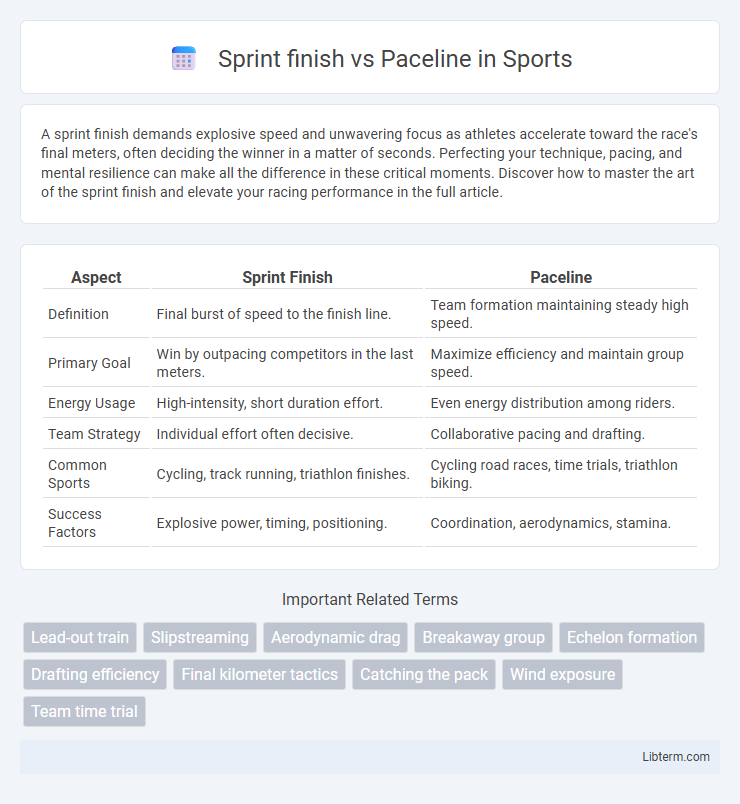A sprint finish demands explosive speed and unwavering focus as athletes accelerate toward the race's final meters, often deciding the winner in a matter of seconds. Perfecting your technique, pacing, and mental resilience can make all the difference in these critical moments. Discover how to master the art of the sprint finish and elevate your racing performance in the full article.
Table of Comparison
| Aspect | Sprint Finish | Paceline |
|---|---|---|
| Definition | Final burst of speed to the finish line. | Team formation maintaining steady high speed. |
| Primary Goal | Win by outpacing competitors in the last meters. | Maximize efficiency and maintain group speed. |
| Energy Usage | High-intensity, short duration effort. | Even energy distribution among riders. |
| Team Strategy | Individual effort often decisive. | Collaborative pacing and drafting. |
| Common Sports | Cycling, track running, triathlon finishes. | Cycling road races, time trials, triathlon biking. |
| Success Factors | Explosive power, timing, positioning. | Coordination, aerodynamics, stamina. |
Understanding Sprint Finishes in Cycling
Sprint finishes in cycling require explosive power and precise timing as riders accelerate intensely over the final meters to outpace competitors. Unlike pacelines, where cyclists maintain a steady, aerodynamic formation to conserve energy and share effort, sprint finishes emphasize individual strength and positioning to maximize speed. Mastering sprint finishes involves analyzing opponents' tactics, optimizing gear shifts, and maintaining optimal rider posture for rapid acceleration.
What is a Paceline? Key Concepts
A paceline is a cycling formation where riders line up closely behind one another to reduce wind resistance and conserve energy. Key concepts include drafting, where the lead cyclist breaks the wind, allowing followers to expend less effort, and rotating positions to share workload evenly. This technique enhances overall speed and efficiency during group rides and races.
Tactics: Sprint Finish vs. Paceline Strategies
Sprint finish tactics prioritize explosive power and timing, requiring riders to conserve energy throughout the race before unleashing a maximum effort in the final meters. In contrast, paceline strategies emphasize sustained high-speed drafting and aerodynamic efficiency, allowing the group to maintain a faster overall pace and control race dynamics. Effective race execution depends on recognizing when to shift from steady pacing to an all-out sprint, often influenced by team roles and competitor positioning.
Energy Conservation: Drafting and Efficiency
Sprint finishes require explosive energy bursts, making energy conservation through drafting less effective than in a paceline, where riders maintain high speeds by closely following each other to reduce air resistance. In a paceline, cyclists share the workload, rotating positions to optimize aerodynamic efficiency and conserve energy for longer durations. This sustained drafting strategy maximizes stamina and power output, contrasting with the all-out effort needed in sprint finishes.
Role of Teamwork in Both Scenarios
Sprint finish and paceline scenarios both highlight the critical role of teamwork in cycling performance. In a sprint finish, teammates position their sprinter optimally, providing slipstreams and shelter from wind to preserve energy for a powerful final burst. During pacelines, riders share the workload by rotating the lead, maintaining high speed and aerodynamic efficiency through coordinated effort and communication.
Speed Dynamics: Acceleration vs. Sustained Pace
Sprint finish involves rapid acceleration within the last moments of a race, relying on explosive power and peak speed to outpace competitors in a short burst. Paceline emphasizes a sustained, consistent pace where cyclists rotate positions, sharing aerodynamic drag and conserving energy to maintain higher average speeds over longer distances. Understanding the contrast between sprint finish's quick acceleration and paceline's endurance-based speed dynamics is crucial for race strategy optimization.
Psychological Aspects: Pressure and Timing
Sprint finish pushes cyclists to manage intense psychological pressure as they must carefully time their explosive effort while resisting anxiety from competitors' proximity. In contrast, riding in a paceline distributes mental load by sharing aerodynamic drag and pacing responsibility, reducing individual stress but requiring constant situational awareness and trust in teammates. Effective timing during a sprint demands sharp focus and confidence, while maintaining cohesion in a paceline depends on synchronized communication and collective rhythm.
Common Mistakes in Sprint Finishes and Pacelines
Common mistakes in sprint finishes include launching the sprint too early, resulting in premature fatigue and loss of speed, and failing to maintain an aerodynamic position, which increases drag. In pacelines, typical errors are inconsistent pacing that disrupts the group's rhythm and insufficient communication, leading to dangerous gaps or sudden braking. Both scenarios demand precise timing, teamwork, and situational awareness to optimize performance and safety in competitive cycling.
Equipment Choices for Sprints and Pacelines
Sprint finishes demand aerodynamic helmets, lightweight, stiff frames, and high-profile carbon wheels to maximize power transfer and reduce drag during explosive efforts, whereas pacelines prioritize comfort and efficiency with balanced gear ratios, durable frames, and aerodynamic but ventilated helmets for sustained high-speed drafting. Sprint-specific equipment often includes power meters and clipless pedals to optimize explosive power output, while paceline riders focus on aerodynamic skin suits and sunglasses to minimize wind resistance and maintain visibility over long distances. Tire selection for sprints favors ultra-fast, low rolling resistance tires at higher pressures, contrasting with paceline setups that use wider, puncture-resistant tires for stability and endurance in group riding conditions.
Which is Better? Choosing the Right Strategy
Sprint finish and paceline strategies serve distinct purposes in cycling, with sprint finishes favoring explosive power for short bursts and pacelines optimizing sustained speed through aerodynamic drafting. Selecting the right strategy depends on rider strengths and race conditions; sprinters benefit from conserving energy in a paceline before unleashing a powerful final burst. Evaluating terrain, competition, and team dynamics ensures a candidate strategy maximizes speed and endurance effectively.
Sprint finish Infographic

 libterm.com
libterm.com